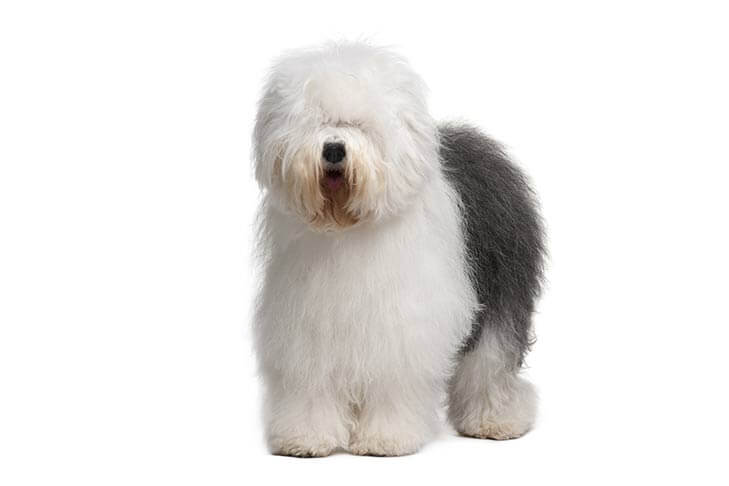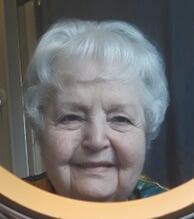Interview with Herding Group Breeder Dianne McKee-Rowland
Where do I live? How many years in dogs? How many years as a breeder?
Dianne McKee-Rowland: I live in Salem, Oregon. Having a mother who showed her Peke and always had one in our home, I was a co-breeder with her of a litter born in 1952. I began my love affair with Old English Sheepdogs (OES) in 1962. I have been a breeder for almost 60 years.
What is my kennel name? How many dogs do I currently keep?
Dianne McKee-Rowland: My kennel name, Blue Panda Reg. was chosen, and the kennel founded, in 1963. Currently, there are five Old English Sheepdogs at home.
Which show dogs from the past have been my noteworthy winners?
Dianne McKee-Rowland: Noteworthy winners include: Ch. Polar Paw Blue Panda, who was never defeated by another female; Am. & Can. CH Blue Panda Party Doll; Am. & Can. CH Blue Panda Snow Knight (BISS); Am. & Can. CH Trosambe Blue Panda St. Owly CDZ (Can. UD, Best in Show Winner in US and Canada); Am. & Can. CH Trosambe Blue Panda Shawn (Am. & Can. CD, Best in Show in Canada); Am. CH Trosambe Blue Panda Smuggler CD; Am. CH Blue Panda Snow Wizard; Am. & Can. CH Blue Panda Desert Dreamer (BIS & BISS); Am. CH Blue Panda Kissing Bandit CD RN CGC; Am. CH Blue Panda Artiaus CD RN CGC; Bog CH Blue Panda Azulado (Multiple, BIS); Bog CH Blue Panda Highway to the Stars at Azuloso (Multiple BIS); and GCHS Lorien The Portrait.
Which have been my most influential sires and dams?
Dianne McKee-Rowland: Influential sires and dams include: CH Polar Paw Blue Panda; Am. & Can. CH Blue Panda Party Doll; Am. & Can. CH Bluedover Beau Aaron; Am. & Can. CH Blue Panda Snow Knight (BISS); Am. & Can. CH Trosambe Blue Panda St. Owly CDX Can. UD (Best in Show Winner in US and Canada); Am. CH Blue Panda Pure Basic Beauty CD RN; Am. CH Blue Panda Pure Basic Bobtail RN; Am. CH Blue Panda Bracken’s Timbre; Am. & Can. CH Blue Panda Desert Dreamer (BIS & BISS); Am. CH Blue Panda Kissing Bandit CD RN CGC; Am. CH Blue Panda Artiaus CD RN CGC; Bog CH Blue Panda Azulado (Multiple BIS); and Bog CH Blue Panda Highway to the Stars at Azuloso (Multiple BIS).
Can I talk a bit about my facilities? Where are my puppies whelped? How are they raised?
Dianne McKee-Rowland: Our puppies are raised between our recliners and the TV. They are never out of sight. We use the plastic wading pools as they are easy to see into and turn to get to a pup on the far side. They are easy to clean and allow the female to slide down the side and avoid lying on the babies. The puppies are handled frequently, which teaches trust in being touched, and moved about, which helps with their overall development.
What is my “process” for selecting show puppies? At what age do I make my decisions?
Dianne McKee-Rowland: Our evaluations are made over the entire 8 to 10 weeks when they are first growing. We pay attention to how they use their legs and bodies. It is easy to see proportions, and those do not change. Personalities are encouraged to develop, and pups are given constant encouragement and handling.
How do I prepare my pups for the show ring? Does my breed require any special preparation?
Dianne McKee-Rowland: We pay little to no attention to markings, and we watch heads, necks, bodies, and legs develop. All breeds require at least a minimum of socialization and exposure to what they will experience in the show ring. We do much more with car rides for no reason except to hear and smell different surroundings. Pups are crated for travel safety. We visit a nearby airport often. When possible, we visit farms to introduce them to livestock. We also follow parts of the programs developed by the service dog groups such as introductions to wheelchairs, walkers, and crutches, etc. We also use different voice levels and tones. The grooming is gentle but firmly constant and thorough. The coat is tugged on to represent a matt being caught by the comb. It is critical to remember that dogs are not born with tolerance, so this must be taught. We have had jewelry worn by judges caught in our dogs’ coats with no repurcussion. They are encouraged to play dead and will even take naps on the grooming tables, which we teach are places of treats and affection. They are regularly bathed and blow-dried. Ears are cleaned and teeth are gently scraped. We handle every inch of their bodies, including teeth and toes. Nails are trimmed and pads are scissored or shaved. In essence, we do as much as we can to introduce the pups to what they might encounter in their new homes. Half of the litter, in turn, will wear light collars with 6-inch leashes attached. The other puppies will tug on these leashes and inadvertently leash-break each other. This is done for short, monitored time periods. Later on, each puppy is walked for further training and to learn ring procedures. They are taught to sit, stay, and come as well as learn to wait until invited to move through doors or get onto furniture, etc.
Is my breed hand-stacked or free-stacked in the show ring? Why is it presented in this manner?
Dianne McKee-Rowland: We hand-stack because it is easier to present the dog by hand than by taking the time to try to get them to walk into a good position. We only have about two minutes of time for examination by the judge. Then there is the coat to get into good form.
Are Performance and Companion titles important to me as a breeder? Are parent club titles?
Dianne McKee-Rowland: Yes. We do like to see titles at both ends, as this demonstrates the ability and willingness of our dogs to learn and do. Our parent club only recognizes Register of Merit, which is simply a dog that produces titled get. Getting the dog out and doing some agility, rally, carting, dock diving, obedience, nosework, lure coursing, and more is always “a plus” to enhance the dog’s life and promote the breed. There’s not much the OES is not capable of learning, and each new thing enhances their lives. They need not compete to enjoy these outings, but for those who like adding titles, most of these offer several levels of competition.
In my opinion, is my breed in good condition overall? Any trends that warrant concern?
Dianne McKee-Rowland: Sadly, our breed has declined, overall, with the possible exception of the aspect of health; with more emphasis being put on breeding tested dogs. The mistaken beliefs about breeding “Doodles” have been a definite detriment to our pure-breeding efforts. Then there is my own soapbox about an all too often lack of attention to our standard by judges. I sometimes turn and walk away with tears in my eyes when I see a judge engaged in “Pretty Picture” judging by “looking” instead of demonstrating care and attention with “knowing” hands finding the basic, important points of our breed. Judges have the ultimate responsibility to keep our dogs bred to the standard. They have the right to withhold ribbons from exhibits that do not exhibit those qualities that match our standard. Rewarding handling or eye-catching grooming only helps with the current downward spiral, which is evidenced by our lower numbers of breeders, exhibitors, and entries. I consider judges to be responsible, in large part, for the quality of OES being bred. “If it won a ribbon, it must be good.” This is a cruel fallacy and is killing our breed. If a judge is not willing to actually learn our standard, and they are not going to really evaluate the exhibits presented, I do not consider them appropriate to judge OES and would hope that they not accept assignments to judge OES.
Is my breed well-suited to be a family dog? Who are the best candidates to own my breed?
Dianne McKee-Rowland: OES should be brought up properly, which will make them suitable family dogs. As a breed, they are well-known as herders but are also historically used as cart dogs, gun dogs, and sled dogs as well as lap dogs. They can be used as sniffer dogs for a number of jobs by law enforcement, as well as search and rescue for reality and for fun competitions.
Do I feel that my breed is supported by a sufficient number of preservation breeders?
Dianne McKee-Rowland: As a preservation breeder, I have outlived many of my mentors and peers. I do not see a lot of others demonstrating behaviors that would identify them as earning that name. It takes dedication to all aspects of involvement with our OES. Breeding is easy; just put two dogs together. What takes the time and effort is seeing to the proper education of the dogs and their new owners as well as involving all interested people in all aspects of being deserving dog owners. There are numerous opportunities to better the lives of our dogs, not just by providing a home and food but by letting them be ambassadors and teachers. Get them out and about and educate people about our breed and its attributes. But you must not neglect the pros and cons of owning an OES.
For a bit of fun, what’s the most amusing thing I’ve ever experienced with a Herding Dog?
Dianne McKee-Rowland: I have had a young dog so interested in getting to know sheep that he came at me so quickly and could not stop in time, knocking me for a loop. Unfortunately, the tester was right behind me and, of course, she went flying too. Of course, the pup was enthralled with his two new play pals.
Anything else I would like to share about myself? Any special message I have for all of us in the fancy?
Dianne McKee-Rowland: Today’s circumstances require each of us to be ambassadors for our breed. We must all pay attention to details and fair play. It is critical that we get back to the basics of showing dogs for the value of evaluation by knowledgeable judges. The show ring is not for the garnering of ribbons and trophies but for measuring our quality of breeding stock. Our judges need to be educated or even re-educated as to our expectations for the future of our breed. It is up to all of us to get back our backbone and our willingness to actively promote our breed as it should be, and not just as a plush puppy.










